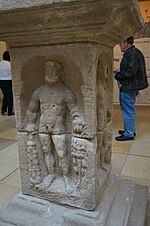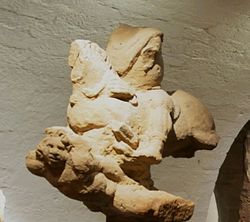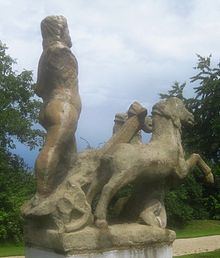Jupiter giant column from Walheim
|
Replica of the giant column of Jupiter in Walheim |
|
| Location | Walheim |
| Emergence | 2nd / 3rd century |
| excavation | 1967 |
| Depository | Limes Museum Aalen Roman Lapidarium Stuttgart |
| material | House sandstone |
| Total height | about 6 meters |
| capital | 51 × 68 cm |
| Column shaft | 260.5 × 41/36 cm |
| Intermediate socket | 78 × 50 cm |
| Viergötterstein | 99 x 52-54 cm |
The Jupiter giant column of Walheim is a consecration memorial for Jupiter , which was built in the 2nd / 3rd centuries. Century near the former Roman cohort fort in Walheim . During an excavation in 1967, almost all of the remains of the column, except for the Gigantenreiter, were recovered, later also the Gigantenreiter.
The remains are kept in the Limes Museum in Aalen and in the Roman Lapidarium in Stuttgart . Replicas of the column were set up in Aalen , Benningen am Neckar , Bexbach , Hechingen , Köngen , Pforzheim and Walheim .
Cover picture: Replica of the giant Jupiter column from Walheim in front of the Museum Römerhaus Walheim
(→ picture comment ).
description
In his monograph on the Upper Germanic Jupiter Columns , Gerhard Bauchhenß traces the "custom of the Jupiter Columns so widespread in Upper Germany and Gaul" to two roots:
- "The native, largely Celtic population brought with them the idea of a god to be worshiped in the form of a tree."
- "The Great Jupiter Column in Mainz , which stands entirely in Roman tradition, provided the impetus for translating the tree cult into stone monuments."
The approximately six meter high Jupiter giant column from Walheim follows this tradition. The column made of parlor sandstone consists of a cuboid four-god stone , above which a round intermediate plinth and the column shaft with the capital and the giant rider sculpture rise.
Viergötterstein
The 99 cm high stone of the four gods rested on a partially preserved foundation plate. It has a square floor plan and ends with a profiled base and cover plate. On the sides of the Viergötterstein has four reliefs in rectangular, framed niches with double arches.
|
| number | position | Gods | presentation |
|---|---|---|---|
| 1 | front | Juno , mother of gods | Dressed woman with scepter, who sacrifices on a small altar. |
| 2 | right | Minerva , goddess of wisdom | Dressed woman with helmet, lance, shield and owl. |
| 3 | back | Hercules , demigod | Bearded man with club, lion skin and hesperid apples. |
| 4th | Left | Mercury , god of commerce | Man with curly hair, winged hat, snake staff and purse, flanked by a buck and a rooster. |
Intermediate socket
The 78 cm high, round intermediate plinth ends with a profiled base and cover plate. Eight niches with reliefs of gods are embedded in the intermediate plinth. The niches are flanked by columns with cube capitals and end with single or double arches and a triangular pediment. The table shows the reliefs in clockwise order.
|
| number | God | presentation |
|---|---|---|
| 1 | Victoria , goddess of victory | Winged female figure with a naked torso. Write on an oval sign with your right hand. |
| 2 | Fortuna , goddess of luck | Dressed female figure with cornucopia and rudder. |
| 3 | Jupiter , father of gods | Enthroned man with beard, curly hair and bared torso. With a bundle of lightning in his left hand. |
| 4th | Apollo , god of the arts | Curly man with a lyre. |
| 5 | Juno , mother of gods | Dressed female figure with a cylindrical box ( pyxis ). |
| 6th | Vulkan , god of the forge | Man with a beard, curly hair, felt hat ( pilos ) and work skirt ( exomis ) leans on an anvil with a hammer. |
| 7th |
Vesta (?), Goddess of home and hearth or Venus (?), Goddess of love |
Dressed female figure with veil and bent arms. |
| 8th | Mars , god of war | Man with helmet, tank, lance and shield. |
Column shaft
The column shaft, including the base and capital, is over three meters high and has a diameter of 41 cm above the base and 36 cm below the capital. The Attic column base consists of a plate ( plinth ) and two strong bulges separated by a throat. The shaft consists of two drums, swells slightly in the middle and tapers towards the top. In the lower part it is decorated with hanging scales that are bordered at the top by a herringbone-like double-leaf frieze. The upper part of the shaft is decorated with motifs from viticulture. From palmette N type bushes three strong, draped with oversized grape vines grow. People, erotes and birds pick the berries in the branched vines , in between predatory snakes and foxes (?)
|
capital
The 51 cm high and 68 cm wide in the center Corinthian capital is enclosed at the base by a wreath of acanthus leaves . The side surfaces have head reliefs surrounded by foliage between the broken corner volutes. The two surviving reliefs show a bearded long-haired man and a woman with long hair. The capital is crowned by a retracted cover plate ( abacus ).
|
Giant rider
The figure of the giant rider represents an allegory of the gigantomachy , the battle of the giants against Jupiter and the Olympian gods , in which Jupiter was victorious.
The heavily damaged Gigantenreiter was found later after the original excavation. The following are preserved: Jupiter without head, with partially broken off limbs and the base of the coat, the horse with torso and head but without legs, and the giant. Because of the severe damage to the Walheim giant rider, the giant rider of the Jupiter giant column from Hausen an der Zaber was used as a model for the reconstruction.
The thunderstorm god Jupiter blows away on his horse with a bare chest and a coat billowing in the wind, the reins in his left hand and a bundle of lightning in his right hand. The horse rears up at a gallop over a naked giant who seals on the ground on hands and snake feet.
history
Emergence
The Jupiter giant column of Walheim was in 2/3. Erected in the 19th century as a consecration monument to Jupiter, the highest god of the Romans. Walheim belonged to the Roman province of Upper Germany ( Germania superior ), in whose area remains of over a hundred columns of Jupiter's giants have been found. The site was near the former Roman cohort fort in Walheim .
excavation
During construction work in 1967, almost all of the remains of the column, even if they were severely damaged, were recovered except for the Gigantenreiter. The heavily damaged giant rider was found later. The following are preserved: Jupiter without a head, with a cloak and partially broken off limbs, the horse with a torso and head but without legs, and the giant. The finds are in the possession of the State Museum Stuttgart . The torso of the giant rider can be viewed in the Roman Lapidarium in Stuttgart. Replicas of the giant column of Jupiter have been set up at several #locations .
|
Locations
The sculpture finds from the giant Jupiter column from Walheim are kept in the Roman Lapidarium in Stuttgart. Based on the original finds, the giant column of Jupiter was reconstructed in its original size and erected in Walheim. Other replicas are in Aalen, Benningen am Neckar, Bexbach, Hechingen, Köngen and Pforzheim.
| place | Location | description | map | ||
|---|---|---|---|---|---|
| Bask | Limes Museum Aalen , Sankt-Johann-Straße 5. | In the old Roman town of Aalen, which was formerly located directly on the Upper German-Rhaetian Limes , a replica of the Jupiter giant column from Walheim is on display in the Limes Museum. |
|
||
| Benningen am Neckar | West of the town hall, Studionstraße 10. |
|
|
||
| Bexbach | Bexbacher Flower Garden, Niederbexbacher Strasse 62. | On the Höcherberg near Bexbach in Saarland , a stone of the four gods was found in the 16th century and is now in the Palatinate History Museum in Speyer . A replica of the Jupiter giant column from Walheim, which was set up in the Bexbach flower garden, commemorates this find. | |||
| Güglingen | Deutscher Hof 10, in front of the Cisterna di Vino restaurant. |
A Roman settlement was located in the area of the city of Güglingen from the 2nd to the 3rd century. In the cityscape you often come across Roman stone monuments. They were installed in various parts of the town as part of the city center renovation to commemorate the city's Roman past. A replica of the four-god stone of the Jupiter giant column of Walheim was set up in the German court. The marble sculpture “Steinzeitung”, a work by the Kubach-Wilmsen team from 1982, rests on it. |
|
||
| Hechingen - stone | Roman Open Air Museum Hechingen-Stein . | In Roman times there was a settlement near the small village of Stein, a district of Hechingen, on the site of which the Hechingen-Stein Roman Open Air Museum was set up. During excavations, parts of a giant column of Jupiter were also found, but they were not sufficient for a reconstruction. As a reminder, a replica of the Jupiter giant column from Walheim was set up at the Roman estate ( Villa rustica ) in the open-air museum. |
|
||
| Kings | Römerpark, Bahnhofstrasse 1. | The municipality of Köngen is located in the area of a Roman settlement on the Neckar-Odenwald-Limes . Today there is an archaeological park, the Roman Park, on the site of the former fort . To commemorate the Roman era, a replica of the Jupiter giant column from Walheim was set up by the watchtower on the south corner of the park. |
|
||
| Pforzheim | In front of the Kappelhof Archaeological Site, Altstätter Straße 26. | The city of Pforzheim goes back to a Roman settlement on an Enz -Furt. The fragments of several large columns of Jupiter are exhibited in the archaeological site, including a relatively well-preserved giant rider. To commemorate these non-reconstructable columns, a replica of the Jupiter giant column from Walheim was set up in front of the archaeological museum. | |||
| Stuttgart-center | Planie, in the New Castle. | The Roman Lapidarium in the New Palace in Stuttgart keeps the original fragments of the Jupiter giant column from Walheim. The torso of the giant rider can be viewed in the display collection of the lapidarium. |
|
||
| Walheim | In front of the Museum Römerhaus Walheim , Römerstraße 16. | The Roman house in Walheim contains a Roman strip house that has been completely preserved in its foundation walls . In front of the Roman house, a replica of the giant column of Jupiter was erected, the original fragments of which are kept in the Roman Lapidarium in Stuttgart. |
|
|
literature
General
- Gerhard Bauchhenß: The giant columns of Iupiter in the Roman province. Germania superior. In: Gerhard Bauchhenß ; Peter Noelke : The columns of Iupiter in the Germanic provinces. Cologne 1981, especially pages 237-238, plate 48.3.
- Philipp Filtzinger : The giant Jupiter column from Walheim. In: Fund reports Baden-Württemberg , Volume 1, 1974, pages 437-482, online .
- Philipp Filtzinger : Hic saxa loquuntur: Roman stone monuments in the Lapidarium Stiftsfruchtkasten and in the exhibition "The Romans in Württemberg" in the Old Castle = This is where the stones talk. Aalen 1980, pages 145–146, illustration on page 143, number 6.
Auxiliary literature
- Enrico De Gennaro: Roman stone monuments in Güglingen's urban area. Güglingen 2013, pages 3–5.
- Meinrad Schaab , Hansmartin Schwarzmaier (ed.) A. a .: Handbook of Baden-Württemberg History . Volume 1: General History. Part 1: From prehistoric times to the end of the Hohenstaufen. Edited on behalf of the Commission for Historical Regional Studies in Baden-Württemberg . Klett-Cotta, Stuttgart 2001, ISBN 3-608-91465-X , p. 174, online .
Web links
- Description, literature list and many photos on the Ubi erat lupa website .
Footnotes
- ↑ Column except giant rider.
- ↑ Giant Riders.
- ↑ Filtzinger 1974, page 465.
- ↑ Total height (probably without Gigantenreiter) according to Bauchhenß 1981, page 237: 536 cm, total height (including Gigantenreiter) according to Schaab 2001: about 6 meters. - Other dimensions: Filtzinger 1974, pages 465–474.
- ↑ height × mean diameter.
- ↑ Height including base × width above the base / width below the capital.
- ↑ height × diameter.
- ↑ height × width.
- ↑ Bauchhenß 1981, page 41.
- ↑ Filtzinger 1974, page 465.
- ↑ Filtzinger 1974, pages 465-469; Bauchhenß 1981, page 238. - Filtzinger lists the reliefs to the left, and Bauchhenß to the right.
- ↑ After Bauchhenß: Juno.
- ↑ According to Bauchhenß: Merkur.
- ↑ According to Bauchhenß: Fortuna (?) Or Maia (?).
- ↑ After Bauchhenß: Venus (?).
- ↑ Filtzinger 1974, pages 469-474; Bauchhenß 1981, page 238.
- ↑ Filtzinger 1974, pages 474, 476-477; Bauchhenß 1981, page 238.
- ↑ Bauchhenß 1981, page 3.
- ↑ Filtzinger 1974, pp. 437-443, 474-480.
- ↑ Website of the Benningen community ( memento of the original from March 20, 2016 in the Internet Archive ) Info: The archive link was automatically inserted and not yet checked. Please check the original and archive link according to the instructions and then remove this notice. , Bauchhenß 1981, pp. 102-103.
- ↑ De Gennaro 2013.
- ↑ In the Römermuseum Güglingen the fragment of a four-god stone is exhibited, which probably comes from the Roman settlement near Güglingen (De Gennaro, pages 7–8).
- ↑ Stadtwiki Pforzheim-Enz .





















